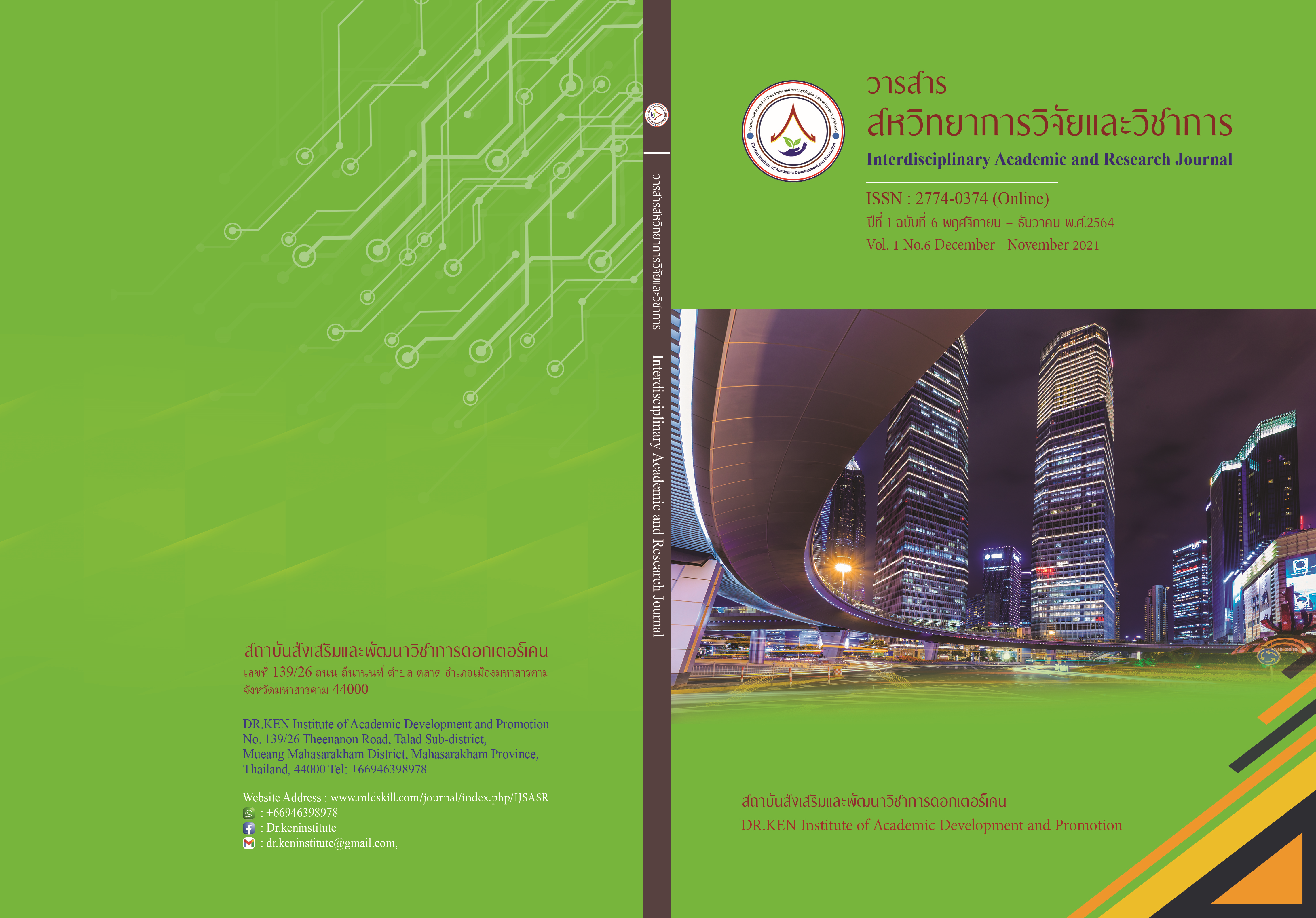Ecotourism Development of Maeyao Sub-district Municipality, Muang District, Chiangrai Province
DOI:
https://doi.org/10.14456/iarj.2021.27Keywords:
Ecotourism, Ecotourism development, Tourism management.Abstract
This research aimed (1) to study activities and potential in tourism management of Maeyao Municipality, Muang District, Chiangrai Province. (2) to study ecotourism development of Maeyao Municipality, Muang District, Chiangrai Province. And (3) to analyze promoting guideline ecotourism development of Maeyao Municipality, Muang District, Chiangrai Province by qualitative methods. The data was collected by semi-structured interviews from 16 persons who were Maeyao municipality staff, community entrepreneurs, community leaders, and members, and tourists and analyzed by using content analysis and summarize. The results showed that:
1. The activities and potential in tourism management of Maeyao Municipality, Muang District, Chiangrai Province were found there had 10 tourist attractions and 4 tourism activities consist of the Sightseeing tour, Trekking tour, cultural tourism activities, and homestays, and educational tourism activities.
2. The ecotourism development of Maeyao Municipality, Muang District, Chiangrai Province showed (1) For tourism area, there were developed tourist attractions such as parking, travel route sign, Village entrance sign, including infrastructure; water systems, electrical systems, toilets, and waste management. (2) For tourism management; there were planned for tourist attraction development, established security measures and tourist property, setting the number of tourists in the tourism area, doing public media, established a tourist information center including community internet service, budget allocation, followed up and evaluated the ecotourism development of Maeyao Municipality. (3) For education and awareness, the staff is given the knowledge of ecotourism and homestay management, good hygiene and waste management, and people development by study visits, teaching the students, and English communication and technology training for community entrepreneurs, community leaders, and members. (4) For community participation and income distribution, the Maeyao Municipality supported budgeting to doing public media, tourism promoting, and building the ethnic group tourism network.
3. The promoting guideline ecotourism development of Maeyao Municipality, Muang District, Chiangrai Province were (1) they should survey and evaluate the tourist attractions for planning and improving the tourist attractions sustainably. (2) they should create the digital media, budget acquisition, and allocation suitably, making various travel programs. (3) they should create the content of tourism attractions briefly and clearly for the tourists. (4) they should set the tourism program and travel route by bringing the identity of tribal cultural tourism with community participation for selling to the tourists, including to generate income for people in the community.
References
กระทรวงการท่องเที่ยวและกีฬา. (2560). แผนพัฒนาการท่องเที่ยวแห่งชาติ ฉบับที่ 2 (พ.ศ.2560-2564). กรุงเทพฯ : กระทรวงการท่องเที่ยวและกีฬา.
กองเศรษฐกิจการท่องเที่ยวและกีฬา. (2563). สถานการณ์ด้านการท่องเที่ยวเดือนธันวาคม 2562. (ออนไลน์). สืบค้นเมื่อ 18 ธันวาคม 2563 จาก https://www.mots.go.th/download/article/article_ 202001231 32729.pdf
คณะกรรมการบริหารงานจังหวัดแบบบูรณาการจังหวัดเชียงราย. (2561). แผนพัฒนาจังหวัดเชียงราย พ.ศ.2561-2564. เชียงราย : สำนักงานจังหวัดเชียงราย.
ณัฐภัค เสถียรุจิกานนท์ และวัชรี เพ็ชรวงษ์. (2559). การพัฒนารูปแบบการท่องเที่ยวเชิงอนุรักษ์ ณ อยุธยาเมืองมรดกโลก สำหรับนักท่องเที่ยวชาวต่างชาติที่มาเป็นครอบครัว. พระนครศรีอยุธยา : สถาบันวิจัยและพัฒนา มหาวิทยาลัยเทคโนโลยีราชมงคลสุวรรณภูมิ.
ธเนศ ทวีบุรุษ. (2557). แนวทางการจัดการท่องเที่ยวเชิงนิเวศชุมชะแล้ ตำบลชะแล้ อำเภอสิงหนคร จังหวัดสงขลา. วิทยานิพนธ์ศิลปศาสตรมหาบัณฑิต สาขาวิชาพัฒนามนุษย์และสังคม. มหาวิทยาลัยสงขลา นครินทร์.
นิธี สีแพร. (2562). Responsible Tourism จุดประกายการท่องเที่ยวอย่างรับผิดชอบ. (ออนไลน์). สืบค้นเมื่อ18 ธันวาคม 2563 จาก http://tatacademy.com/th/news/295
ปาริฉัตร สิงห์ศักดิ์ตระกูล และคณะ. (2553). ศักยภาพและแนวทางการพัฒนาการท่องเที่ยวเชิงอนุรักษ์ของชุมชนบ้านทุ่งมะปรัง อำเภอควรโดน และบ้านโตนปาหนัน อำเภอควรกาหลง จังหวัดสตูล. สุทธิปริทัศน์. 27 (83), 97-112.
ภัทร์ธนกัลย์ เตี่ยไพบูลย์. (2557). ศักยภาพแหล่งท่องเที่ยวเชิงนิเวศโดยชุมชน บ้านหัวนอนวัด ตำบลแม่ทอม อำเภอบางกล่ำ จังหวัดสงขลา. วิทยานิพนธ์วิทยาศาสตรมหาบัณฑิต สาขาวิชาการจัดการสิ่งแวดล้อม. มหาวิทยาลัยสงขลานครินทร์.
ยุวดี นิรัตน์ตระกูล. (2539). Eco-tourism: การท่องเที่ยวเชิงอนุรักษ์. วารสารศูนย์การศึกษาต่อเนื่อง มหาวิทยาลัยขอนแก่น. 4 (1), 45.
ศุภขุน ประชุมกาเยาะมาต. (2559). การจัดการการท่องเที่ยวเชิงอนุรักษ์โดยชุมชน กรณีศึกษา แหล่งท่องเที่ยวน้ำตกยะลูตง ตำบลกาเยาะมาตี อำเภอบางเจาะ จังหวัดนราธวาส. (ออนไลน์). สืบค้นเมื่อ 18 ธันวาคม 2563 จาก http://www.islocal.ru.ac.th/images/ispdf/is59/5924884505.pdf
สนธยา พลศรี. (2547). ทฤษฎีและหลักการพัฒนาชุมชน. (พิมพ์ครั้งที่ 5). กรุงเทพฯ : โอเดียนสโตร์.
Downloads
Published
How to Cite
Issue
Section
License
Copyright (c) 2021 Interdisciplinary Academic and Research Journal ISSN 2774-0373 (Online)

This work is licensed under a Creative Commons Attribution-NonCommercial-NoDerivatives 4.0 International License.
Copyright on any article in the Interdisciplinary Academic and Research Journal is retained by the author(s) under the under the Creative Commons Attribution-NonCommercial-NoDerivatives 4.0 International License. Permission to use text, content, images, etc. of publication. Any user to read, download, copy, distribute, print, search, or link to the full texts of articles, crawl them for indexing, pass them as data to software, or use them for any other lawful purpose. But do not use it for commercial use or with the intent to benefit any business.
















.png)


